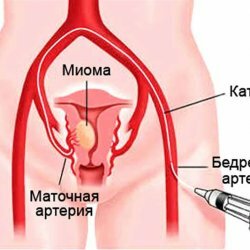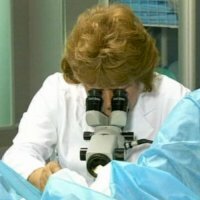Embolization of uterine arteries
 Uterine artery embolization is a minimally invasive intervention that has been used for more than 20 years in obstetrics and gynecology to stop bleeding that occurs as a result of labor or surgery.
Uterine artery embolization is a minimally invasive intervention that has been used for more than 20 years in obstetrics and gynecology to stop bleeding that occurs as a result of labor or surgery.
This procedure is often prescribed to patients with a diagnosis of uterine fibroids. It can replace conservative treatment. During this procedure, the femoral artery is punctured, resulting in occlusion( occlusion) of the blood vessels. The operation is performed under local anesthesia, so the pain is almost not felt.
Earlier, women who were diagnosed with uterine fibroids were given a resection or complete removal of the uterus. In many cases, the reason for this decision was a high probability of degeneration of the fibroids into a malignant form. Women usually do not easily endure amputation of the uterus. Among the negative consequences - problems with urination, inflammation of the postoperative scar, hematoma, peritonitis, pulmonary embolism, bleeding. Amputation of the uterus often leads to severe depression, but is still used, and remains one of the most common methods in gynecological surgery.
Description of the procedure
It is a new treatment method that helps many women avoid a complex operation with a lot of negative consequences. A positive effect is achieved as a result of the cessation of blood flow to the fibromatous nodes by blocking the blood flow. Due to this procedure, a fairly rapid decrease in fibroid is observed. What is the essence of the intervention? In the inguinal fold, a small puncture is made, allowing embolus to be placed in the uterine artery. At the introduction, the X-ray equipment is used, which makes it possible to monitor the movement of the catheter. The endovascular surgeon closely follows this process, gradually brings the embolus to the branch point of the uterine artery. The therapeutic process consists of such successive stages: puncture of the femoral artery, catheterization of the uterine vessels, the introduction of a drug that overlaps their lumen. It ends after the blockage of all the vessels responsible for supplying myomas with blood. To achieve the best results, embolization takes place on both sides of the arteries leading to the myoma. Termination of blood supply to the nodes is confirmed by a control arteriogram. Those places where punctures were made, carefully processed with an antiseptic solution, tightly covered with a sterile dressing, and remain in a compressed state for 12 hours.
Purpose of the
method The treatment method is chosen depending on the clinical classification of the disease. Myoma is small, medium and large. There are also submucous fibroids and fibroids on the foot.
In the presence of a small education( 1-2 cm), the patient is assigned an intrauterine release system or combined oral contraceptives( COCs).
Medium-sized fibroids( 3-4 cm) require a two-stage treatment. For large fibroids( 4.5 cm or more) embolization of uterine arteries or conservative myomectomy, involving the removal of fibroids, is performed.
Submucosal formations, having a size of not more than 3 cm, are subject to hysteroresectoscopy, and fibroids on the leg - laparoscopic removal, which is performed with minimal disruption of the skin through a small hole.
For any procedure, there are indications and contraindications. Embolization of the arteries of the uterus is indicated when a uterine myoma is found, the growth of which continues, or the symptoms corresponding to this disease.
Procedure is recommended to pass:
- if the size of the uterus corresponds to its condition in the presence of pregnancy for a period of 7-20 weeks( the procedure is never carried out with pathologies of the cervix, ovaries and endometrium);In cases where its size is smaller, embolization is not recommended, sinceThe effect will be negligible;To obtain a good result, the uterus must have a size corresponding to its size during pregnancy for at least 7 weeks;
- to eliminate the negative impact of fibroids if a woman wants to maintain reproductive function( with a high probability of miscarriage, infertility);
- as a preparatory stage, preceding hysteroresectoscopy( intrauterine surgery) or myoectamy( removal of myoma);
- with abundant uterine bleeding of different etiology, when this method is the most safe for the patient from all existing treatment options.
Contraindications
Embolization is not performed with severe allergies to used drugs, which causes anaphylactic shock or Quincke's edema, is contraindicated in infectious diseases.
Advantages of the
procedure If you compare the embolization of the uterine arteries with other treatments, you can see many benefits. The positive aspects include:
- first of all it is necessary to distinguish - the possibility of curing without surgical intervention with preservation of the uterus;
- after the procedure, the woman retains her reproductive capacity;
- on the skin there are no significant lesions and large scars, only two punctures are made, the traces of which quickly disappear;
- there is no need to apply general anesthesia, local enough;
- recovery is very fast, it requires 8-hour bed rest;
- in some cases, there may be a pain or a fever, this is extremely rare, but it is still possible;These unpleasant phenomena are easily eliminated by the passage of a small course consisting of painkillers and anti-inflammatory drugs.
Women who have undergone uterine artery embolization respond positively to this procedure. This unanimity testifies to the speed( lasts no more than 10 minutes) and painlessness of its conduct. In addition to full preservation of all functions of the uterus, there is a cessation of tumor growth, its decrease in size occurs at a fairly rapid pace.
It should be noted that lately uterine fibroids are increasingly found in young girls who have not yet had a baby and enjoy the joy of motherhood, have not fully entered adulthood.
At this time in modern clinics embolization of the uterine arteries is quite an expensive procedure, which is not available to every person. But this method is really highly effective, it allows you to completely heal, it is worth the money spent. The total cost of the procedure includes the price of the materials, tools and embolizing drug used, as well as the cost of the doctor's services and supervision during the stay in the hospital.



